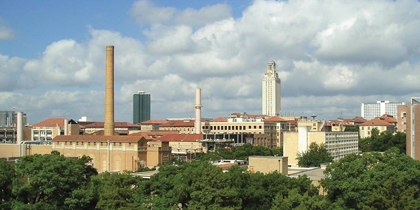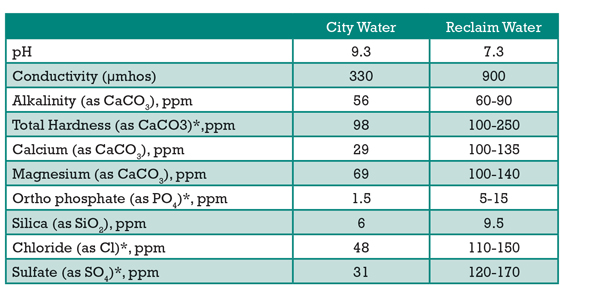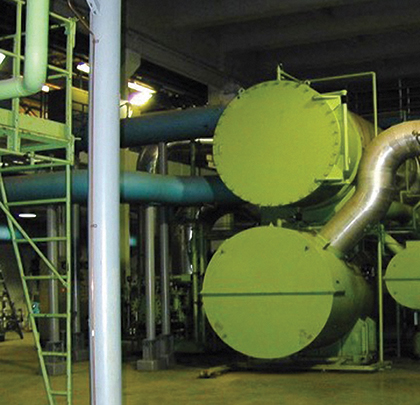The University of Texas at Austin power plants provide heating and air conditioning for two hundred buildings totaling over one-hundred million cubic feet of air space in offices, lecture halls, classrooms, laboratories, kitchens, cafeterias, and dormitories. The air conditioning is derived from 6 miles (9.7 kilometers) of underground chilled water loops.
Texas has been under moderate to severe drought conditions. The University of Texas at Austin’s cooling water use for power generation and chilled water production was around 350 million gallons per year. The chilling station water use was 245 million gallons (927 million liters) annually. They buy water from the City of Austin which costs $13.45/1,000 gallons for water and sewer—$5.22 for fresh water and $8.23 to discharge it to the sewer. As an alternative, the city offered reclaimed wastewater at a cost of $1.50 per 1000 gallons (3785 liters).
The university elected to bring reclaim water to the campus, selecting Chilling Station 5 as the trial site. They replaced roughly 80 million gallons (302 million liters) of treated potable water with City reclaim wastewater at a savings of almost $300,000 a year.
IDENTIFICATION OF OBJECTIVES FOR SYSTEMS WITH RECLAIM WATER
Before committing to a reclaimed water program, the university required a study to justify the expense of bringing the water to the campus. U.S. Water evaluated the facilities and proposed a combination of service, equipment, and chemistry that would:
- Decrease the corrosion rates in distribution lines, heat transfer stations, and refrigeration units.
- Eliminate fouling that impeded desired temperature control at all locations.
- Minimize water losses from rust-damaged lines.
- Minimize corrosion from microbiological sources.
- Decrease the energy cost to create the chilled water.
- Extend the life of seals, pumps, and heat exchangers.
The water treatment challenges presented by the reclaimed wastewater (see figure 1) included high concentrations of organic carbon which had the potential to increase energy robbing biofilm growth, high total phosphate and ortho-phosphate with attendant deposit potential, and high chloride and sulfate residuals contributing to increased potential for localized corrosion. Like many distributive cooling systems, the university equipment cycles on and off according to need. Off-line condensers are subject to solids precipitation and subsequent fouling or corrosion.

University of Texas at Austin
IMPLEMENTING THE WATER TREATMENT PROGRAM
U.S. Water implemented a water treatment program to minimize issues in off-line condensers by activating pumps at full flow for two to four hours, three days per week. This action reduced the settling of solids while introducing microbicides and fresh inhibitors. They formulated a custom polymer blend to address the stresses of using reclaimed water with high hardness and phosphate in the chilled water loops. Condenser water boxes and tube sheets were epoxy coated to reduce corrosion potential, and acid pH control was established to minimize insulating deposits on heat transfer surfaces.
U.S. Water established a microbiological and biofilm control program, which included continuously feeding chlorine based on real time control using ORP (Oxidation – Reduction Potential) technology, chlorine dioxide fed in timed additions several times a week for additional biofilm control and lastly, a non-oxidizing microbicide fed weekly.

Figure 1: City water vs. reclaim water quality
A LOOK AHEAD
In next month’s conclusion, we’ll take a close look at the U.S. Water web-based data management program, which provided access to real time conditions for both technical personnel and the client, as well as summarize the program’s achievements in successfully replacing potable water. ◆
Dinu Filip is president of ACO Systems, Ltd. ACO Polymer Products, Inc. introduced the concept of modular trench drains to North America over thirty years ago. ACO specializes in the manufacture of drainage products utilizing polymer concrete, cast iron foundry and plastic extrusion. Today, ACO manufactures a range of drainage and landscape products from polymer concrete, stainless steel, mild steel, cast iron, fiberglass, and molded plastics. These diverse material types are used to produce components for all applications: commercial and residential construction, as well as electromechanical engineering and environmental protection. ACO USA is a part of the ACO Group, which employs more than 3800 people worldwide in forty countries, with production facilities in North America, Europe, China and Australia. These resources, supplemented with a worldwide network of agents, make superior-quality ACO products available in every corner of the world.
____________________________________________
MODERN PUMPING TODAY, August 2015
Did you enjoy this article?
Subscribe to the FREE Digital Edition of Modern Pumping Today Magazine!
![]()


